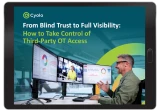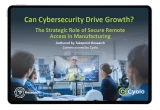Table of Contents
Busting a Longstanding OT Security Myth
Let's talk about access control.
Is it necessary? Absolutely.
Is it popular? Probably not so much.
If you work with operational technology (OT) or cyber-physical systems (CPS), chances are you’ve encountered an access tool that was supposed to keep you secure but mostly just got in your way.
Maybe it required system reboots that led to operational delays. Or demanded endless password prompts during a mission-critical task. Issues like this frequently arise when security tools clearly built for IT are parachuted into industrial environments, where they just don’t fit.
So it’s really no wonder so many operations teams see access controls as a hassle – something you work around, not with.
But here’s the twist: security really isn’t there to slow you down. Like brakes on a car, it’s what lets you go faster – safely. Security gives you control, so your teams can move at speed.
So, once and for all, let’s debunk the myth that security means sacrificing productivity – and explore what ops teams actually want from access control.
Where the Security ≠ Productivity Myth Came From
Security in OT didn’t get a bad reputation by accident. It was built over years of mismatched tools and misaligned priorities.
IT-centric tools – built for desktops, emails, and office networks – flopped once they hit the plant floor:
Password resets triggered at the worst times
Authentication steps multiplied like rabbits
Bloated interfaces hogged system resources
Some controls even disrupted real-time systems – freezing up PLCs (programmable logic controllers), or breaking the precise timing that OT systems rely on
Add to that a culture clash: IT teams wanted top-down corporate controls, while OT teams needed uptime, safety, and autonomy for operators. Security became a tug-of-war between policy and practicality.
The result? Tools that made jobs harder, not safer – slowing operations, breaking focus, and making security feel like a blocker, not a backup.
So the myth stuck: more control means less productivity. And for a long time, that mindset held firm. But today, it’s beginning to lose its grip.
A new study from Takepoint Research and Cyolo shows a growing number of security and ops professionals in the manufacturing industry now see strong remote access as a speed boost, not a roadblock:
67% say Secure Remote Access (SRA) improves collaboration with third-party vendors
58% say SRA increases productivity and/or efficiency
50% say SRA reduces cost savings
42% say SRA improves compliance
Long story short, security solutions like SRA enable productivity with its foot on the gas.
The Real Threat is Security that Forces Users to Break the Rules
The problem isn’t control – it’s how that control is designed and implemented.
When security becomes a brick wall, people find workarounds. USB sticks sneak in. Personal laptops get connected to critical systems. Shared logins spread like gossip – not out of malice, but in the name of keeping things moving.
Ironically, these so-called ‘productivity hacks’ are what introduce real risk. One shortcut might save a few seconds today, but it could cost days of downtime after a breach. Plus, workarounds create a parallel ecosystem of shadow access – and you can’t secure what you can’t see.
So, you might be asking, what actually speeds things up? Strong, seamless remote access controls. No more sending out trucks, flying engineers around the world, or delaying critical fixes until the right technician can reach your facility. With Secure Remote Access (SRA), you can act from anywhere – without compromising safety.
TL;DR: Security isn’t the problem. Badly implemented security is.
What Operations Teams Actually Want from a Remote Access Tool
Nobody asks for security controls that micromanage their every move. But visibility still matters.
What ops teams really want is simple:
Tools that do their jobs without causing delays or disruptions
Access policies that let the right people do the right work, right away
What does that look like in practice?
Access verification according to identity and role, not overly wide network access or too-strict one-size-fits-none permissions
Just-in-time, task-specific access that lets users (whether employees or third-party contractors) solve problems fast and keeps operations moving
Single sign-on (SSO) with password injection so you’re not juggling half a dozen logins just to start your shift
Session monitoring that runs quietly in the background, stepping in only when something’s off, not flagging every click
But most importantly – to meet OT security needs, tools must adapt.
The best access controls available today are context-aware, automated, and precise – built to move with your team, not trip them up.
This means they can:
Adjust access policies based on who’s logging in, where they are, and what device they’re using – without adding extra steps or login requirements
Grant or revoke access automatically, based on the task, time, or role – no support ticket needed
Provide just enough access to get the job done – for just as long as needed. Nothing more, nothing less.
It’s not about relaxing control, it’s about fine-tuning it – protecting your team without slamming the brakes on their productivity.
Secure Remote Access Should Provide Maximum Impact with Minimal Disruption
The best access control solution doesn’t bring your work to a halt or add ten extra steps to every task. It’s quiet. Invisible, even.
Operators log in once, access what they need – ideally via a single dashboard – and get on with it. No friction, delays, or urgent calls to the help desk. Meanwhile, security teams still get full visibility: who did what, when, and where – without intrusion, delay, or anyone needing to change how they work.
That’s how the best modern security supports OT:
Drama-free deployment – fast to set up, easy to scale
Application-first architecture – exposing only the tools you need, not the whole network
Infrastructure-agnostic design – modernize without ripping and replacing what already works
The goal? Access that wraps around your real-world cyber-physical systems – and then gets out of your way. Because the most secure system isn’t the loudest one. It’s the one your team actually uses – and barely notices.
Looking for a new SRA solution that will integrate seamlessly into your existing OT and CPS environments? Don't make a decision without checking out our recently published Manufacturers’ Guide to Secure Remote Access for OT.
Can Cybersecurity Drive Growth?
Discover the strategic role of Secure Remote Access in manufacturing

Jennifer Tullman-Botzer
Author
Jennifer Tullman-Botzer has over a decade of experience in cybersecurity marketing and is as tired as you are of hackers-in-hoodies stock images. She joined Cyolo in 2021 and currently serves as Head of Content. Prior to Cyolo, Jennifer worked in a variety of marketing roles at IBM Security. She lives in Tel Aviv, Israel.

Subscribe to Our Newsletter







